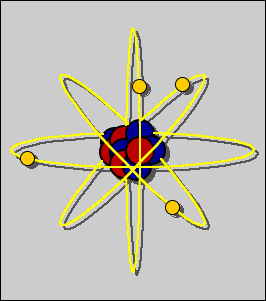Chronological Methods 8 - Radiocarbon Dating

Radiocarbon, or Carbon-14, dating is probably one of the most widely used and best known absolute dating methods. It was developed by J. R. Arnold and W. F. Libby in 1949, and has become an indispensable part of the archaeologist's tool kit since. It's development revolutionized archaeology by providing a means of dating deposits independent of artifacts and local stratigraphic sequences. This allowed for the establishment of world-wide chronologies.
Where does C -14 Come From?
Radiocarbon dating relies on a simple natural phenomenon. As the Earth's upper atmosphere is bombarded by cosmic radiation, atmospheric nitrogen is broken down into an unstable isotope of carbon - carbon 14 (C-14).
 Bombardment
Bombardment
 Reactions
Reactions
The unstable isotope is brought to Earth by atmospheric activity, such as storms, and becomes fixed in the biosphere. Because it reacts identically to C-12 and C-13, C-14 becomes attached to complex organic molecules through photosynthesis in plants and becomes part of their molecular makeup. Animals eating those plants in turn absorb Carbon-14 as well as the stable isotopes. This process of ingesting C-14 continues as long as the plant or animal remains alive.
 Diffusion
Diffusion
 Ingestion
Ingestion
C-14 Decay Profile
The C-14 within an organism is continually decaying into stable carbon isotopes, but since the organism is absorbing more C-14 during its life, the ratio of C-14 to C-12 remains about the same as the ratio in the atmosphere. When the organism dies, the ratio of C-14 within its carcass begins to gradually decrease. The rate of decrease is 1/2 the quantity at death every 5,730 years. That is the half-life of C-14. The animation provides an example of how this logarithmic decay occurs. Click on the "Show Movie" button below to view this animation.
 C-14 Decay Profile
C-14 Decay Profile
How is a C-14 Sample Processed?
Clicking on the "Show Movie" button below will bring up an animation that illustrates how a C-14 sample is processed and the calculations involved in arriving at a date. This is actually a mini-simulator, in that it processes a different sample each time and generates different dates.
 C-14 Processing
C-14 Processing
The Limitations of Carbon 14 Dating
Using this technique, almost any sample of organic material can be directly dated. There are a number of limitations, however.
- First, the size of the archaeological sample is important. Larger samples
are better, because purification and distillation remove some matter. Although
new techniques for working with very small samples have been developed, like
accelerator dating, these are very expensive and still somewhat experimental.
- Second, great care must be taken in collecting and packing samples to avoid
contamination by more recent carbon. For each sample, clean trowels should
be used, to avoid cross contamination between samples. The samples should
be packaged in chemically neutral materials to avoid picking up new C-14 from
the packaging. The packaging should also be airtight to avoid contact with
atmospheric C-14. Also, the stratigraphy should be carefully examined to determine
that a carbon sample location was not contaminated by carbon from a later
or an earlier period.
- Third, because the decay rate is logarithmic, radiocarbon dating has significant
upper and lower limits. It is not very accurate for fairly recent deposits.
In recent deposits so little decay has occurred that the error factor (the
standard deviation) may be larger than the date obtained. The practical upper
limit is about 50,000 years, because so little C-14 remains after almost 9
half-lives that it may be hard to detect and obtain an accurate reading, regardless
of the size of the sample.
- Fourth, the ratio of C-14 to C-12 in the atmosphere is not constant. Although
it was originally thought that there has always been about the same ratio,
radiocarbon samples taken and cross dated using other techniques like dendrochronology
have shown that the ratio of C-14 to C-12 has varied significantly during
the history of the Earth. This variation is due to changes in the intensity
of the cosmic radation bombardment of the Earth, and changes in the effectiveness
of the Van Allen belts and the upper atmosphere to deflect that bombardment.
For example, because of the recent depletion of the ozone layer in the stratosphere,
we can expect there to be more C-14 in the atmosphere today than there was
20-30 years ago. To compensate for this variation, dates obtained from radiocarbon
laboratories are now corrected using standard calibration tables developed
in the past 15-20 years. When reading archaeological reports, be sure to check
if the carbon-14 dates reported have been calibrated or not.
- Finally, although radiocarbon dating is the most common and widely used
chronometric technique in archaeology today, it is not infallable. In general,
single dates should not be trusted. Whenever possible multiple samples should
be collected and dated from associated strata. The trend of the samples will
provide a ball park estimate of the actual date of deposition. The trade-off
between radiocarbon dating and other techniques, like dendrochronology, is
that we exchange precision for a wider geographical and temporal range. That
is the true benefit of radicarbon dating, that it can be employed anywhere
in the world, and does have a 50,000 year range. Using radicarbon dating,
archaeologists during the past 30 years have been able to obtain a much needed
global perspective on the timing of major prehistoric events such as the development
of agriculture in varous parts of the world.
Links
Radiocarbon Journal
References

